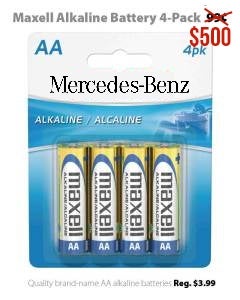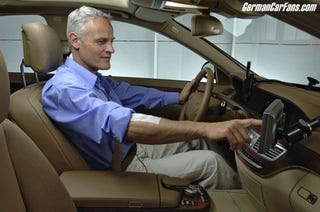
There's a difference between being cheap and treasuring value per dollar spent. One is knowing where the best burger joint is, and the other is going up to other tables and asking for unwanted leftovers and spare ketchup packets. Understanding this distinction is the reason why almost exactly one year ago I purchased a used Mercedes-Benz S500 and drove it daily. Here are a few things I learned along the way.
5. It's way cheaper than you think.
We all understand depreciation. It's the free market's way of telling you that the shiny thing that everyone wanted yesterday is now worthless because a new shiny thing that blows it out of the water just dropped this morning, and you're a big fat nothing if you don't drop everything and get it NOW. This makes things very interesting in the used car market. The values most affected (read: destroyed) are those of luxury cars due to low demand, high production numbers, and a clientele more fragile than the skin-like membrane wrapped around the indestructible exoskeleton of Kim Kardashian's offspring.
Let's put some numbers behind the rhetoric:
A 4-door 2014 Honda Accord EX-L, with no extra options checked, will set you back $30,287 (MSRP).
My 2000 Mercedes S500, with many options ticked, had an MSRP of $85,419 when new.
I bought the S500 in 2013, with 89,000 miles on it, for $3000. I bought it non-running, with electrical issues.
Full disclosure: To clarify, electrical issues can be a nightmare in a car this complex, but they are very easily solved if you understand how these cars work and aren't afraid to get your hands dirty. I did a bit of research on a few forums and found that the ignition module (where the key goes, known as the EIS) is a port for the car's Controller Area Network (CAN) Bus. I decided that this would be a good place to start. After taking the dash apart, I found the problem and managed to find an ECU, EIS, and shifter from the same model year locally for $350. This got rid of any trips to the dealer because the parts were all "married" to each other and required no further version coding. I installed these parts in less than an hour and I got the car running as if it was new, with no warning lights on the dash. I did have to install a replacement accelerator pedal, as the old one had an intermittent fault that would put the car into limp mode. Since the car was drive-by-wire, it was a matter of removing a 10mm bolt and disconnecting a clip and the problem was fixed with a good used part.
Here's what I spent fixing maintaining, and updating it over the year I've had it:
If I factor the initial price of the car, I've spent $4335, which is $25,952 less than the Accord. At that point, you have to realistically ask yourself, would you rather have one Honda Accord, or a fleet of German luxury cars?
- Key, ECU, shifter combo, USED - $350
- Replacement accelerator pedal, USED - $50
- Both rear Airmatic struts, NEW, with installation - $650
- Mobil-1 Synthetic Oil change - $100
- One HID headlight ballast, USED - $40
- Serpentine Belt and Idler Pulley, NEW - $80
- Bluetooth Module and Noise Filter, NEW - $65

Pictured: You can have everything in this picture, or a brand new Toyota Corolla. Your choice.
4. Cheap stuff is oddly expensive.
Although the car was cheap in the long run, things that were supposed to be cheap in any other car suddenly became made of some rare isotope of unobtainium. I wanted to get a set of keys made for the car, since I only had one. I went to the local locksmith with a used key from a previous ignition that I wanted re-coded for my car, and they acted as if I just ordered them to predict winning lottery numbers at gunpoint. My keys were laser cut and one-time dealer encoded, meaning that no one else could ever re-encode them, so it meant my spare key was now as good as the rocks the store so eloquently told me to kick. After reaching out to the Mercedes dealership, a factory-cut key would be $400. That's only 10 times what a regular transponder key would've cost. That's a steep price to pay for something that will literally sit in a drawer and collect dust until the batteries die.
The battery on a regular car would cost anywhere from $60-$120. A Mercedes battery? $350 on the low end, because it's a dry-cell AGM design that is specifically made for the car's sensitive electrics, like a therapist tailored to a 13-year old suffering from a case of Affluenza.
How about a fresh fillup of fluids? You can't take it to the Jiffy Lube because they don't carry the $20 a quart Pentosin synthetic hydraulic fluid that your power steering system needs. Don't think you can get a transmission flush either without shelling out $20 a quart x 9 to replace all the Automatic Transmission fluid in the pan, versus $1.99 x 5 a quart for the regular stuff. Motor oil? $10-$18 a quart times 9, with a $10-$20 filter. You won't have to change it for another 9500 miles, but it's a pretty insane cost either way. It's as if you did the grocery shopping, didn't change your diet, and left the store realizing you just paid $300 for a sack of apples.

Pictured: Pretty much.
3. It's surprisingly easy to repair.
Although this car had over 200 patents filed for its various features before its initial release, mechanically it's no more complex than a medium-sized birdhouse. All of the interior is held on with either clips or small torx screws, and exterior panels all have cleary visible bolts with lots of clearance for tools. The engine is a big, lazy single overhead cam V8 with two spark plugs per cylinder and an air filter and ducting assembly that requires no tools to remove. There aren't any expensive timing belt services to do and no expensive turbos or superchargers to blow expensive and hard-to-reach seals. The air suspension consists of 3 bolts at the top with an air line connection and one bolt on the bottom. I priced out the labor a local shop would charge to replace a rear air shock assembly, and instead of giving me a price that resembled my phone number, they told me $70, and it was done in a few hours.

Pictured: This is the look of a man who got to keep BOTH kidneys after his Mercedes broke down.
If you want to really be on top of things, you can get a STAR Diagnostic scanner, or just pay a shop to run a scan for you, and check all of the car's electrical systems to make sure nothing else needs to be replaced. Fortunately my car was in good shape and the only electrical work it needed was the initial EIS repair. This kind of stuff isn't limited to MB, BMW has similar specs on their cars and have pretty reasonable repair rates for their mechanicals as well - even less if you can do the stuff yourself.
2. You're going to be a jerk to some people, no matter what.
To outline this point, I'll illustrate a few actual scenarios that have happened to me:
I parked my car near the post office on a busy street, got out and proceeded to retrieve my packages from the backseat. An SUV with more primer than paint, chrome rims from the wrong end of 2001, and altezza taillights rolled up. A guy resembling a halfway point between a loan shark and an actual shark rolled down the window and said the following:
"Hey man! Hey....listen, my wife is in the hospital and I need some cash to get her out. I got my kids here, you think you could give me a little something to keep me going?" He then proceeded to roll down the window and showed me what looked to be either scared biological children or relatively well-behaved hostages. I told him I didn't have any cash on me, which I didn't, and he promptly rolled his eyes, told me to "have a nice fukking day" and drove away, nearly running a red light in the process.
Let me reiterate: This was a populated street, in which he could've asked anyone and didn't need to stop at my rejection. But here I was, with a shiny German luxury car in a sea of dented Accords and used Mazdas, and as the luck of the draw would have it, I got randomly selected by this guy to fund his wife's medical bills. How serendipitous.
In another turn of events, I was making a stop at Subway, and a guy with a dead battery asked me if I could jump his car from mine. I told him that I couldn't, because the electrical system in the car would promptly take a shyt in its own pants if I tried to connect it to something as low-rent as his base model Hyundai or whatever the hell poor people drive nowadays. That wasn't exactly the reason, it actually had something to do with electrical surges, but the guy didn't want to believe that I couldn't help him and was perfectly happy calling me an a$$hole after scoffing as if I'd just urinated on his new shoes. That was OK, it's a little known fact that $5 footlongs taste better when a single tear streams down your cheek.
Finally, at a toll booth out of state, I found myself with no EZPass and no change. I went to the cash receipts lane and asked for an envelope because I didn't have any change to pay for the tolls. The smarmy toll booth operator said, in a singsongy, pseudo-authoritative voice, "You drive that thing and you don't have any money? What's wrong with you?" I said "I spent it all on the car", and took my envelope with a nice steaming slice of embarrassment pie. Joke's on them, I shorted them 10 cents when I sent in the change. WIN.
1. What you're driving is still better than most of the cars on the road today.
There are lots of things technology can account for and improve on as time goes on, but there are still things that are clearly better when you buy a car with a high standard of luxury and an emphasis on build quality - things that a luxury car maker can afford to do that another cost-cutting company wouldn't. For instance, my 14-year old Mercedes has double-paned glass for sound insulation with a layer of air in between so the windows don't fog up. There are rear vanity mirrors, and as many air vents for the backseats as there are for the front seats, with a independantly-controlled zone for each corner. The rear headrests are air-powered and automatically extend when a person in that seat buckles their seatbelt. The audio system detects the noise inside the cabin and adjusts the volume automatically. It even has a strip of fabric that prevents things from falling in between the console and the seat.
EXPAND
The car will do 0-60 in about 6 seconds, and the cabin is quiet enough to whisper to the passengers in the backseat during a full-beans launch, but your efforts will have been in vain, for the air-powered lumbar support and reclining seats have all but guaranteed that they'd be fast asleep before you hit the go pedal. This is the kind of car that's available to anyone for half the price of a used economy car, and not only will everyone think you're rich, you'll be so refreshed and ambitious at the end of your journey that you'll act the part.
http://carbuying.jalopnik.com/5-things-no-one-tells-you-about-owning-a-used-luxury-ca-1582610274

